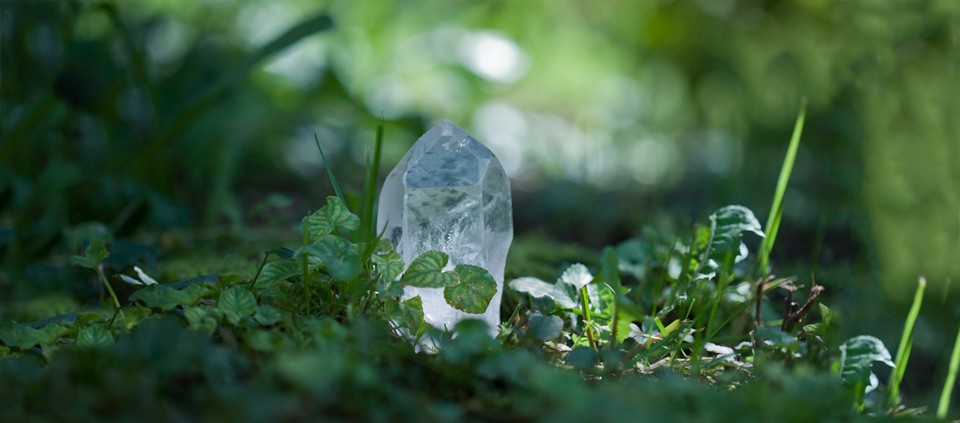Crystal Clear: Can Stones Really Heal Us?

Research has shown that time spent in the woods, as well as in so-called “blue spaces” (close to the ocean, rivers, and lakes), has a positive effect on our health and well-being. Is it possible that another natural element—stones, and specifically crystals—could have the same beneficial properties?
Proponents of crystal healing believe that crystals and gemstones have properties that facilitate the flow of chi, or prana (life-force energy). Some date the practice back some six thousand years, when it was used by ancient Sumerians and Egyptians, who were said to have adorned themselves with crystals, such as lapis lazuli, carnelian, and turquoise, to ward off illness and toxic energy.
Contemporary crystal healers maintain that each stone has specific properties: Amethyst is believed to support intestinal health, green aventurine is good for the heart, yellow topaz boosts mental clarity, etc. Stones or crystals are placed on the body in alignment with the chakras, worn around the neck, carried in your pocket, or tucked under your pillow to protect from sickness and attract positive energy.
Western yogis and meditators have integrated the use of crystals into their practice—as a focal point when set near the yoga mat or held in one hand during meditation, or as a balancing and energizing force when placed on the body during Savasana. Each stone is said to enhance particular qualities—clear quartz for clarity, rose quartz for compassion, amethyst for peace, citrine for abundance, and so on. (You’ll find slightly different information depending where you look.)
“People say crystals can draw out negative energy and store information,” says Micah Mortali, Director of Outdoor Education and Programming at Kripalu, who has been fascinated by stones and crystals since he was a child. He collects them, and sees their power as interconnected with the benefits of being present in nature. “I’ll be out in the woods, walking, and I’ll feel drawn to a particular rock or a tree,” he says. “When I feel stressed or ungrounded, I’ll hold a rock and focus on its mass and weight. If I feel heavy or clouded, I’ll gaze at a clear crystal.”
In his R&R Retreat workshops on the Way of Council, a practice of deep listening and authentic communication, Micah passes around a stone in place of a talking stick. “When the stone is in your hand, you speak what’s in your heart,” he says. “Knowing that others have held it and had the same experience can shift your perspective.”
But do crystals really have powers other than the ones we assign to them? In a study led by Christopher French, head of the anomalistic psychology research unit at the University of London, 80 participants were asked to meditate for five minutes while holding either a real quartz crystal or a fake crystal that they believed was real. Afterward, participants in both groups reported experiencing a tingling in the body, warmth in the hand holding the crystal, increased energy and concentration, and/or an overall feeling of well-being. The researchers found that the effects reported by those who held fake crystals while meditating were no different than the effects reported by those who held real crystals. Researchers credited the results to the placebo effect—which could also be described as the healing power of the mind.
Whether or not their capacities can be proven by science, crystals have an undeniable pull for their beauty, complexity, and ability to refract light in ways that seem almost magical. Micah notes that the mathematical precision in the way they’re formed suggests a kind of sacred geometry. For him, crystals and minerals are a microcosm of the earth element, representing solidity, stability, and strength.
“When I hold an old stone, I feel a profound mystery and humility,” he says. “This rock could have been around for a million years, and it will definitely be around long after I will.”
If you’d like to experiment with using crystals as a focal point in your yoga or meditation practice or in daily life, here’s a guide to how they are said to correspond with the chakras, colors, and elements.
Seventh Chakra
Sahasrara (Thousand-Petaled Lotus)
Location: Crown of the head
Element: Space or spirit
Colors: White or violet
Stones: amethyst, diamond, quartz crystal, selenite, white calcite, white topaz
Sixth Chakra
Ajna (To know)
Location: Third eye
Element: Light
Color: Indigo
Stones: Amethyst, black obsidian, purple fluorite, azurite, tanzanite
Fifth Chakra
Visuddha (To purify)
Location: Throat
Element: Ether
Color: Blue
Stones: Aquamarine, lapis lazuli, turquoise, blue calcite, blue chalcedony
Fourth Chakra
Anahata (Unbroken)
Location: Heart center
Element: Air
Color: Green
Stones: Green calcite, green tourmaline, jade, malachite, green aventurine
Third Chakra
Manipura (Lustrous gem)
Location: Solar plexus
Element: Fire
Color: Yellow
Stones: Orange calcite, citrine, malachite, amber, yellow jasper, golden tiger-eye
Second Chakra
Svadisthana (One’s own abode)
Location: Lower abdomen
Element: Water
Color: Orange
Stones: Carnelian, citrine, coral, moonstone, topaz
First Chakra
Muladhara (Root)
Location: Base of spine
Element: Earth
Color: Red
Stones: Fire agate, black tourmaline, bloodstone, hematite, tiger’s eye, smoky quartz, garnet